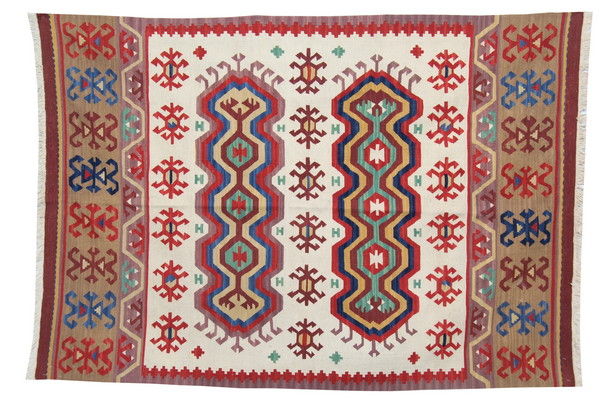Traditional symbols on handwoven rugs bear witness to many of the beliefs and superstitions that are held in central Asian countries… Places where the art of weaving was born and still thrives… Even modern rugs from the region still depict a host of rather interesting symbols.
Most modern eastern rugs replicate traditional designs and motifs, not only because they convey a special message, but also because western people enjoy pondering their meaning. Mysterious symbols are particularly evident in kilim rugs as we shall see…
OK, it’s time to take your kilim rug out and look closely at it… Can you spot one of the following motifs?
Understanding the Symbols On The Rugs

Birth motifs
Elibelinde: This symbol represents the mythological goddess of the same name. By looking closely you can make out the figure of a person.
Ram’s horn: A Ram’s horn symbolises masculinity. The central part of the design represents male fertility and power. This motif is deemed to derive from a spiral synonym of eternity where women hope their men will always remain strong and provide for the family.
Insan: This symbol is a reference to the condition of pregnancy in humans.

Life Symbols
Comb and earrings: These two symbols are important to women because they reflect the desire to marry. The comb is a nuptial accessory, while the earrings are a common wedding gift.

Sandikly – hope chest/ trousseau: This symbol is a reminder of a very important object for girls in eastern countries. Before they marry they spend time weaving objects for their trousseaus (hope chest). These objects include small purses, kilims, scarfs, belts and garments. The content of the chest is not opened until the day of the wedding.

Yildiz- stars: Stars are a symbol of happiness and a life full of hope.
Ying-Yang: This Ying-Yang holds a different meaning to that of the more common Ying-Yang. It symbolises a balanced relationship between women and men.

Protection Of Life Symbols
Su-yolu– running water: This represents life itself. After all, there can be no life without water.

Pitrak: This is a very special plant as it represents protection against the life-threatening evil eye. It is a plant that produces pronged burrs.

Tarak: This represents the desire of a woman to get married, but also means fertility and is a good omen for the union of a woman with her new husband.


Muska – amulet or evil eye: This symbol is considered good protection against the scary evil eye. In many countries it is believed that a simple look could kill, which is why it is important to be protected against enemies. Muska is an amulet against the evil eye but represents an evil eye itself. This is because attack is seen as a good form of defence. The muska symbol is very widespread because of this important protective function.
Cross: This counters the influence of the evil eye. In fact, any crux-shaped object is thought to decrease its devastating effect.
Snake: This is a symbol of fertility and happiness. Contrary to many western perceptions, the snake is a positive symbol.
Dragon: The dragon is a powerful creature, he has various functions: he protects the water, he protects the air, and he is also the guardian of the tree of life and the secrets of the universe. The dragon ultimately symbolises life.

Wolf’s mouth: The wolf is regarded as a valuable animal because he can protect against other wild animals.


AfterLife Symbols
Birds: Birds symbolise the flight of the soul to heaven.
Vulture: This kind of bird is particularly important as it indicates the souls of the dead. At the same time it also has very positive connotations such as happiness, joy and love.
Tree of life: This is the most widely-known symbol of immortality. The history behind it is very intriguing. People cannot eat the fruits of the eternal life tree, but they increase their hopes for life after death by depicting it. When the tree is woven into carpets it is sometimes upside down in order to point out that the roots of life are in the heavens.

The text is sourced by the very authoritative book “Kilim: The Complete Guide” by Thames & Hudson
Kilims As Modern Rugs And Beyond
In the past Kilim rugs were woven mainly by nomadic tribes. Most of these have now settled down to embrace a more sedentary lifestyle. Despite this, nomadic weavers have handed down their cultural knowledge to succeeding generations, and the use of symbols in workshop kilims is still striking and widespread

This fact shows that the knowledge of the symbols has not been lost in transaction to modern times. Rather, it has been mixed with more recent beliefs and history to form an exceptional mixture of the antique and modern, which only heightens our curiosity.
Today’s Kilims are mainly created for export. As a result, they must conform to the tastes of western buyers. However, western buyers are fascinated by Symbols on Modern Rugs motifs deriving from the traditional tribal motifs, so there isn’t much need for compromise in this area. However, rug experts have observed that today’s kilim weavers maintain the original tribal style while partially adopting a new, more modern look.

